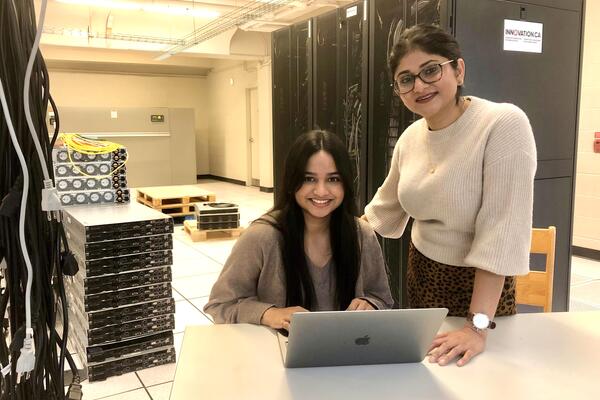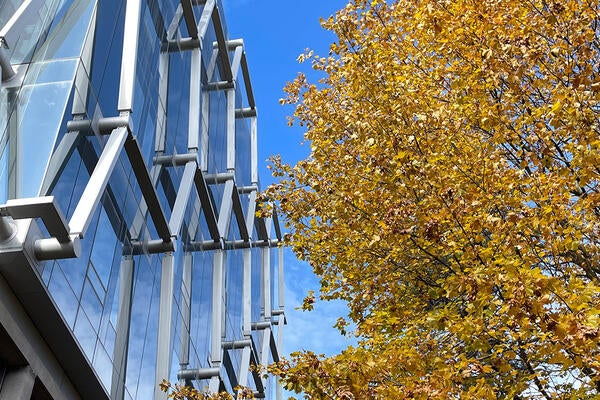
AR/VR can help extend critical infrastructure lifespan
Waterloo engineers have developed a cutting-edge system that will revolutionize structural inspection and management

Waterloo engineers have developed a cutting-edge system that will revolutionize structural inspection and management
By Media RelationsUniversity of Waterloo engineers are turning to augmented/virtual reality (AR/VR) to better understand — and maintain — the physical reality of Canada's critical infrastructure.
On-site inspectors are typically limited in what they can observe when inspecting bridges, roads, towers, pipelines, and other structures because they can't always see or detect every potential problem within large infrastructure
To help fix this issue, Waterloo professor Dr. Chul Min Yeum and his colleagues have developed a cutting-edge system called the Smart Infrastructure Metaverse that uses AR/VR to allow on-site and off-site inspectors to interact with each other as they view both the real structure, and a 3D scanned replica model at the same time.
Not only does their system produce more rapid, comprehensive, and complete results than traditional on-site visual examinations, but it also provides a greater context for problems within the entire structure.
Their innovative work meets an urgent need. Much of Canada's vital infrastructure was constructed in the mid-20th century and is now nearing or exceeding its lifespan, a situation that poses serious public safety risks. Yet replacing these structures would cost a staggering $264.7 billion, according to Canada's Core Public Infrastructure Survey. Yeum's solution combines several advanced technologies so problems can be addressed quickly and the life expectancy of infrastructure extended.
"The Smart Infrastructure Metaverse is all about making it easier for on-site and off-site inspectors to work together on structural inspections," Yeum said. "We're using AR/VR headsets to give them a shared view so they can see exactly where they are and what they're looking at during the inspection, no matter where they're located."
The research team included Yeum and Dr. Zaid Abbas Al-Sabbag, both in Waterloo's Department of Civil and Environmental Engineering, as well as Dr. Sriram Narasimhan, of the Department of Civil and Environmental Engineering, University of California Los Angeles.
In a key experiment focused on a railway bridge in Kitchener, Ontario, Yeum and his colleagues created a three-dimensional model of the structure using 3-D scanners and a panorama camera. This model allowed the accurate tracking of the location and head position of both the on-site and off-site inspectors within the 3-D map.
Next, an off-site engineer wearing a VR headset explored the 3-D model of the bridge the way someone would navigate a VR game. While this was happening, on-site inspectors wearing AR headsets could, through a holographic display, see the actual bridge, the VR user, and additional information within the digital map.
Since everyone in this examination was connected to the digital map, the off-site inspector saw the exact locations of the on-site users along with the areas of the structure they were inspecting. That meant the remote inspector could ensure the data collected was accurate. To back up the human inspectors, the research team used artificial intelligence to analyze the images sent from the on-site inspectors' AR headsets to further identify any structural damage.
Since 2020, Rogers has funded this project as part of the Rogers-University of Waterloo Partnership, identifying it as a compelling use case for 5G technology and mobile edge computing.
More information on this research can be found in the paper, Distributed collaborative inspections through smart infrastructure metaverse, which appears in the September edition of Automation in Construction.

Read more
Here are the people and events behind some of this year’s most compelling Waterloo stories

Engineering master's student Nayeema Nonta (left), one of the three paper authors, and her supervisor, Dr. Sirisha Rambhatla, in a large server room with the computer power needed to develop their new LLM training technique. (University of Waterloo)
Read more
Waterloo researchers develop highly efficient AI training system that paves the way for cheaper, greener “intelligent partners”

Read more
15 University of Waterloo researchers have been named to the annual Highly Cited Researchers™ list for significant contributions to their specific fields of research
The University of Waterloo acknowledges that much of our work takes place on the traditional territory of the Neutral, Anishinaabeg, and Haudenosaunee peoples. Our main campus is situated on the Haldimand Tract, the land granted to the Six Nations that includes six miles on each side of the Grand River. Our active work toward reconciliation takes place across our campuses through research, learning, teaching, and community building, and is co-ordinated within the Office of Indigenous Relations.